
| KIT #: | ? |
| PRICE: | 11 Pounds Sterling |
| DECALS: | One option |
| REVIEWER: | Carmel J. Attard |
| NOTES: |

| HISTORY |
The MB-2 bomber was ordered by the USAAS in June 1920 with view to carry a larger load than its predecessor the MB-1. On the MB-1, two Liberty engines that were suspended between the wings by a system of struts, while on the improved MB-2, the twin Liberty were lowered to sit inside the nacelle attached to lower wing.
The MB-2
was designed specifically as a night bomber but sacrificed the high speed and
maneuverability of the MB-1 for a greater bomb load. Ten MB-2s were built by
Glenn L.Martin in Cleveland. These were redisignated NBS-1 when the new
designation system scheme was reintroduced. Their serials were 64195-64214. The
MB-2 is best remembered today as being the aircraft,
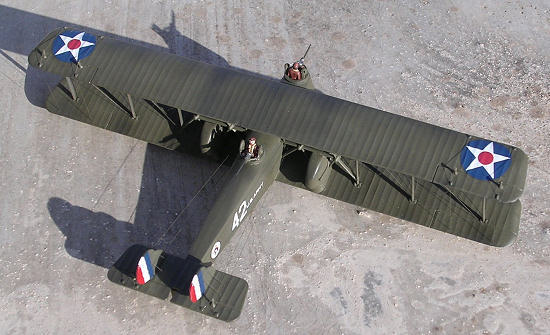 which participated, in the
famous Billy Mitchell demonstration of July 21st 1921 when the
ex-German battle cruiser Ostfreisland was sunk by aerial bombardment using
special 2,000 lb bombs used for the test.
which participated, in the
famous Billy Mitchell demonstration of July 21st 1921 when the
ex-German battle cruiser Ostfreisland was sunk by aerial bombardment using
special 2,000 lb bombs used for the test.
A competitive bid in 1921 resulted that the Curtiss Company underbid the Glenn L.Martin Co. for the production of 50 examples of NBS-1. Other contracts for 35 other NBS-1 granted to LWF (Lowe, Willard & Fowler) Engineering Company of College Point, New York, and a contract for 25 more granted to Aeromarine Plane and Motor Co. of Keyport, New Jersey.
The last 20 Curtiss built NBS-1 bombers were equipped with General Electric turbo superchargers and these were the first aeroplanes to use turbo superchargers in production quantities. Being so equipped the NSB-1 could reach an altitude of 25,300 ft. Eventually the use of superchargers in bombers proved to be premature and notoriously unreliable and practical application of turbo superchargers to bombers came many years later in 1939 on B-17B.
Eight Army bombing squadrons that used the NBS-1 were the 11th, 20th, 49th,and the 96th Sq. No 2 Bombing Group based at Langley Field in Virginia; the 23rd and72 nd Sqd with the 5th Composite Group in Hawaii; and the 28th Sq with 4th Composite Group in the Philippines. They remained in service until replaced by Keystone bombers in 1928-29.
The NBS-1 (MB-2) had a maximum sped of 99 mph at sea level, a cruising speed of 92 mph, landing speed of 59 mph. It had a service ceiling of 8,500 ft, maximum ceiling 9,200 ft. A range of 400 miles with a bomb load of 2,000 lbs. Wing span was 74’2”, length of 42’8” and a height of 14’8”.
| THE KIT |
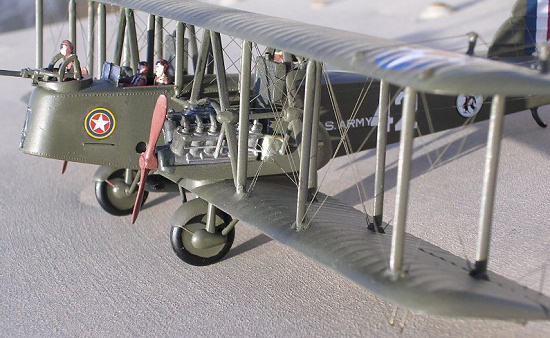 The MB-2 bomber by Glencoe is a
reissued kit and although I bought it from the model shop at Flinders Street,
Melbourne in 1997 the instructions date back to 1988, which is apparently the
time when Glencoe Company acquired the moulds. Box states that the kit is to
1/72 scale but in reality it worked to a scale of 1/74 upon checking. The kit is
moulded in dark green plastic, rather heavy thick sections by today’s kit
standard but the parts are almost free of flash. External detail on kit parts
consist of rather heavy rib detail and rivet detail on the fuselage. As for
interior detail this is very sparse with plain bulkheads and floors. Crews are
provided and I elected to place them on the aircraft for two reasons: they give
indication of size of aircraft and secondly there is lack of interior detail
which apart from being hard to find reference material then the pilot and seat
as well as other crew members take much of the available space and interior
detail even if ever added would be obscure.
The MB-2 bomber by Glencoe is a
reissued kit and although I bought it from the model shop at Flinders Street,
Melbourne in 1997 the instructions date back to 1988, which is apparently the
time when Glencoe Company acquired the moulds. Box states that the kit is to
1/72 scale but in reality it worked to a scale of 1/74 upon checking. The kit is
moulded in dark green plastic, rather heavy thick sections by today’s kit
standard but the parts are almost free of flash. External detail on kit parts
consist of rather heavy rib detail and rivet detail on the fuselage. As for
interior detail this is very sparse with plain bulkheads and floors. Crews are
provided and I elected to place them on the aircraft for two reasons: they give
indication of size of aircraft and secondly there is lack of interior detail
which apart from being hard to find reference material then the pilot and seat
as well as other crew members take much of the available space and interior
detail even if ever added would be obscure.
| CONSTRUCTION |
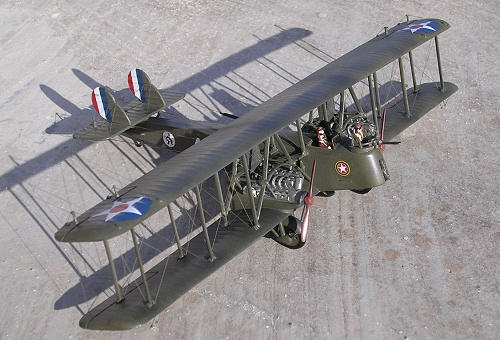 The first
step in building the model is to connect the fuselage halves together, which is
followed by assembling the wing both of which are two-part assembly. When the
lower half is fitted within the leading edge and the trailing edges it leaves a
joint line that is filled in with putty and carefully rubbed and smoothened
sown. This is no difficult task as the ribbing detail is only on the upper side
and I have my doubts if the under side contained no ribbing on the real
aircraft. The tail plane is a single moulding and two fins and rudders are fixed
on it. The sub assembly is then fitted to the fuselage.
The first
step in building the model is to connect the fuselage halves together, which is
followed by assembling the wing both of which are two-part assembly. When the
lower half is fitted within the leading edge and the trailing edges it leaves a
joint line that is filled in with putty and carefully rubbed and smoothened
sown. This is no difficult task as the ribbing detail is only on the upper side
and I have my doubts if the under side contained no ribbing on the real
aircraft. The tail plane is a single moulding and two fins and rudders are fixed
on it. The sub assembly is then fitted to the fuselage.
Now is the
step to place the struts on lower wings. These were somewhat cumbersome and
needed to reduce in size before struts are in place. Rigging holes are now
drilled on the wings. Unfortunately there are no rigging details on the
instructions and the box art cover only provided partial detail in this respect
since the close up picture only shows the front of the aircraft and part of main
wings. So I made reference to “US ARMY and Air Corps Guide” Vol 1. Leaving the
rigging detail for a while I turned my attention to assembling the engines which
are mounted on the lower wing. The exposed engine detail was to create a
contrast in colour finishes with the rest of the aircraft. This was painted at
this stage followed by a somewhat tedious masking j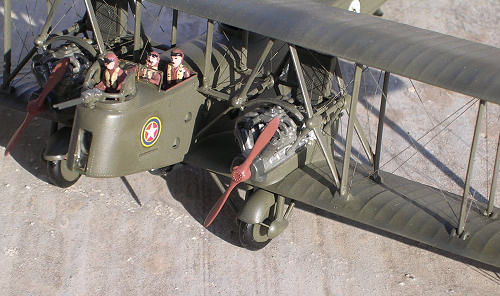 ob
that would need to be removed little by little in the end once the kit and
rigging were complete. Exhausts of engine were added as per artwork as these
were not supplied.
ob
that would need to be removed little by little in the end once the kit and
rigging were complete. Exhausts of engine were added as per artwork as these
were not supplied.
The huge biplane contains 12 whole struts positioned vertically over the wings and around 24 half struts fitted around the engine nacelles and over the fuselage bay area. This is a complex assembly by itself but one should consider that the main structure is moulded in two sections with just the connecting struts being the separate items. With all the struts set in place the upper wing was then lowered and secured on the struts. The outer wing struts consisting of two pairs in all were then slotted into the locating holes. It was then the turn to assemble the undercarriage. The wheels are enclosed in a fairings which are supported by Vee struts with the wheel and axle suspended in holes in the inner side of the fairing. In view of this situation I had to paint the wheels before these were inserted in the undercarriage housing.
| COLORS & MARKINGS |
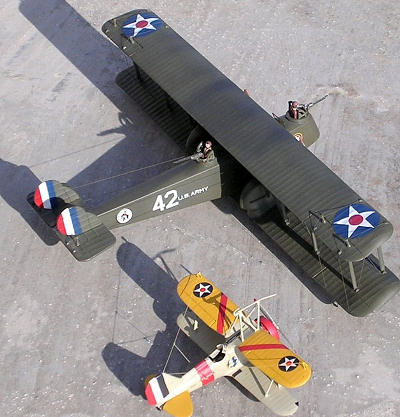 Looking
hindsight I should recall that masking, painting and rigging needed some good
planning in using the most promising sequence. I always prefer to use the
invisible thread method of rigging and only the lack of detail of rigging layout
caused some delay and the job was carried out little by little. Wires were
fitted to side control brackets; again these were on the heavy side and were
reduced in size and reshaped by filing. Another extra work was adding a wind
screen frame with Krystal Kleer added to, modified the guns, added struts to
wheel mud guards and adding some minor cockpit detail. Model was finished in a
lighter shade of olive drab overall having as semi gloss sheen. Decals adhered
well and other refinements added to paintwork of prop hubs, crew figures,
elevator control wires and so on.
Looking
hindsight I should recall that masking, painting and rigging needed some good
planning in using the most promising sequence. I always prefer to use the
invisible thread method of rigging and only the lack of detail of rigging layout
caused some delay and the job was carried out little by little. Wires were
fitted to side control brackets; again these were on the heavy side and were
reduced in size and reshaped by filing. Another extra work was adding a wind
screen frame with Krystal Kleer added to, modified the guns, added struts to
wheel mud guards and adding some minor cockpit detail. Model was finished in a
lighter shade of olive drab overall having as semi gloss sheen. Decals adhered
well and other refinements added to paintwork of prop hubs, crew figures,
elevator control wires and so on.
| CONCLUSIONS |
My Martin MB-2 represents a bomber belonging to the 11th Bombardment squadron, which continued in service until 1928 and carries an ID No 42. This was a pleasant kit to build and at the same a challenge in some respects, but definitely not the type to complete a whole squadron of them.
| REFERENCES |
US Military Aircraft since 1909 (Swanborough & Peter M.Bowers)
Curtiss Aircraft 1907-1947 by Peter M.Bowes. Naval Institute Press 1979
August 2006
Copyright ModelingMadness.com. All rights reserved. No reproduction in part or in whole without express permission from the editor.
If you would like your product reviewed fairly and fairly quickly, please contact the editor or see other details in the Note to Contributors.